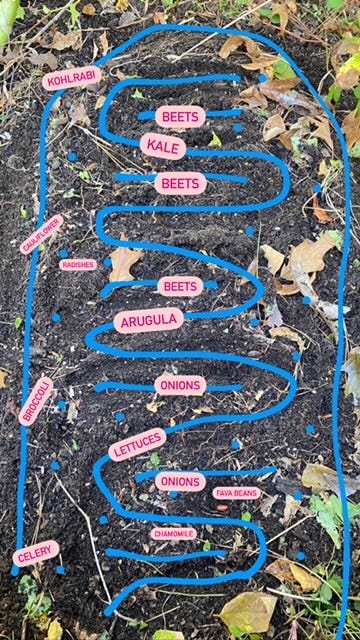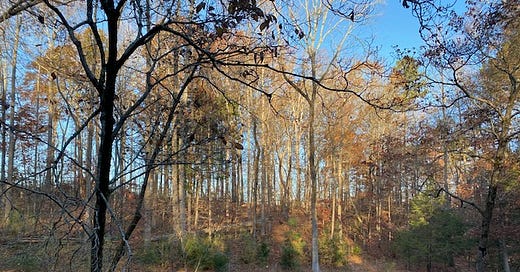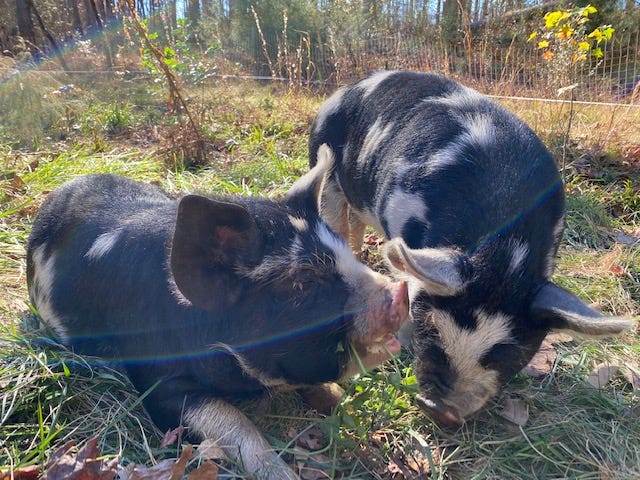Permaculture after the frost: Stacking permaculture principles
Here are a few ways I’m practicing permaculture when it’s not the peak growing season.
One of the many things I love about permaculture is that it’s rooted in a whole systems design approach. Everything becomes more valuable together. It’s an uncertain time of year and odd time in growing history, which means resilient, productive systems are even more important. We’re a few weeks past our first frost, my region of North Carolina is in a drought, wildfires spread on thousands of acres in the neighboring county to my western apiary and two counties over, and the USDA recently changed growing zones in response to climate change. Stacking permaculture systems during this slower time of the year can help boost resiliency year-round and perpetually. I’m doing a few things differently this year and sharing three ways I’m stacking permaculture principles with an eye for the future.

Maximize edges + integrate rather than segregate | I generally plan my growing spaces in curved rows, either S-shapes or C-shapes to allow more microclimates to develop, increase the number of plants in a given space, and add soil diversity through root growth/aeration and nutrient draw/return from plants. One of the things I’m doing differently this fall is creating mini versions of these growing patterns. Instead of a 9’ C-shaped row of broccoli, I’m organizing a 4’ row in three different places, with other plants interplanted in an S-shape. I always interplant to help build biodiversity and set the plants up for success with regard to pest and disease exposure, so I included fava beans, cauliflower, celery, spinach, radishes, carrots, beets, and onions. The fava beans are nitrogen fixers, so they’ll encourage the spinach to get leafy. The spinach leaves and beet greens will serve as a living mulch to shade the soil and help retain moisture. (Important during this time of drought.) The radishes are the temporary piece in the picture. They’ll help to loosen the soil and they won’t disturb the surrounding plants. An easy harvest in a space that would otherwise be unused. Carrots and onions love water, and the former will spread deep into the ground while the latter will use the space along the soil surface. I’ll harvest these plants at different times, but the integration during their main growing time helps to strategically pair nutrients, growing preferences, and space needs.
Use renewable resources and slow solutions | We’re fortunate to have a tremendous density of hardwood trees across the majority of our property. Each year the oaks drop acorns and their leaves, and the hickories drop their nuts and leaves too. I’ve mentioned in earlier posts that “oak hay” (the leaves) is a nutritious food source for swine. The tannins in the oak leaves allegedly help prevent worm, parasite, and other health issues. Since we have this renewable resource and it’s our first fall having pigs, we’re grazing them in the woods at prime time for fresh nuts and fallen leaves. I strategically plotted out the pigs’ rotational grazing plan before they arrived, which took into account predators, the nut and leaf fall, and unloading/loading needs. Tomorrow they move into the woods for the rest of the fall and winter. While they enjoy the forest snacks, I’m looking at the slow evolution of the woods into silvopasture.
Silvopasture is pasture space intentionally planned among trees. As the pigs move through our woods they’ll enjoy the forest snacks that I mentioned. They’ll also root up invasive species and over-competing tree seedlings, their rooting will aerate and loosen the soil (which is rockier in our woodland areas), and their waste will help build soil. As they pass through each paddock I’m seeding cover crops and native seed mixes behind them. We have limited potential pasture space, but a high density of wooded areas, so managing the pigs this way will help slowly nurture silvopasture spaces for future livestock, and also create habitat and forage for wildlife. As our climate changes and our summers in the South continue to get hotter, having shaded silvopasture will provide a more comfortable living space for livestock.Catch and store energy + produce no waste | Our region of North Carolina is generally fairly wet with average annual rainfalls well in excess of 48”. However, sometimes we’re in a drought like we are now. We also may see more drought in the future as the climate continues to be unpredictable. One of the systems I’ve been interested in adding for years is a reclaimed rainwater system. I’ve had an IBC tote, which I bought used, for about 4 years and I haven’t used it yet. Finally, this winter I’m setting up a gutter system and putting that tote to work. I’m hoping to source the gutters used (please comment or email me if you know of some material locally) and I’m re-using free pallets that we acquired for the pigs’ initial paddock as the water tank stand. While I source the gutters over the next few weeks, I’m deciding whether I want to set the tank up next to a larger structure closer to the garden and a future livestock shelter, or if I want to set it up by the chicken coop. I see many pros and cons with both locations, but that’s enough to fill another post.





